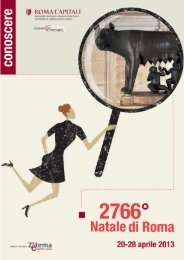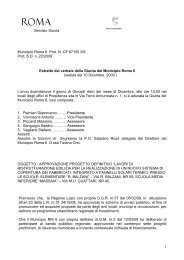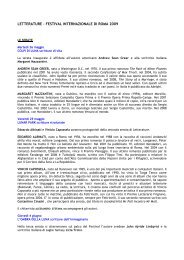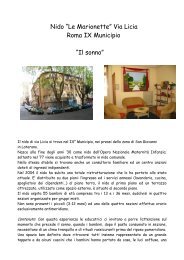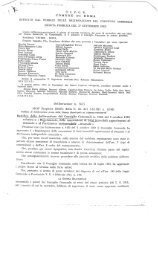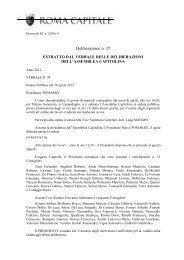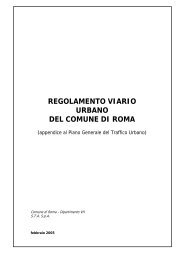Create successful ePaper yourself
Turn your PDF publications into a flip-book with our unique Google optimized e-Paper software.
10<br />
La Grattachecca: un cult romano<br />
Grattachecca: A <strong>Roma</strong>n cult<br />
Rime<strong>di</strong>o dei romani<br />
contro il caldo è la<br />
grattachecca: un mix <strong>di</strong><br />
ghiaccio triturato, sciroppi<br />
e frutta. La Capitale ha<br />
una lunga tra<strong>di</strong>zione che<br />
arriva, attraverso la Persia<br />
e l’antica Grecia, ad<strong>di</strong>rittura<br />
dalla Cina, dove gli<br />
imperatori già tremila<br />
anni fa gustavano la dolce ricetta fatta <strong>di</strong> neve e sciroppi<br />
alla frutta. Deriva il suo nome dal verbo grattare e da<br />
checca, termine con il quale un tempo si identificava il<br />
grosso blocco <strong>di</strong> ghiaccio utilizzato per refrigerare gli alimenti<br />
quando ancora non esistevano i frigoriferi. A <strong>di</strong>fferenza<br />
della granita che viene prodotta con acqua<br />
mescolata a sciroppi e messa a congelare, la grattachecca<br />
è composta da ghiaccio grattato da un singolo<br />
blocco <strong>di</strong> gran<strong>di</strong> <strong>di</strong>mensioni, con un apposito raschietto<br />
provvisto <strong>di</strong> una camera vuota posteriore che consente<br />
<strong>di</strong> accumulare il ghiaccio grattato così ottenuto. Una<br />
volta riempito il bicchiere con il ghiaccio, viene aggiunto<br />
succo <strong>di</strong> frutta o sciroppo. A <strong>Roma</strong> solo pochi chioschi<br />
oramai preparano la grattachecca seguendo la lavorazione<br />
tra<strong>di</strong>zionale ed i più famosi sono localizzati sulle<br />
sponde del Tevere, forse perché rifugio da sempre, per<br />
gli abitanti, dalla calura estiva. Si vocifera che Quinto<br />
Fabio Massimo inventò ai suoi tempi una ricetta che <strong>di</strong>venne<br />
subito molto popolare. La neve portata dal Terminillo<br />
veniva aromatizzata con sostanze dolci. Nacquero a<br />
<strong>Roma</strong> i primi "Thermopolia" (una specie dei chioschi <strong>di</strong><br />
oggi) che <strong>di</strong>stribuivano la refrigerante e <strong>di</strong>ssetante bibita.<br />
Tra i grattacheccari più famosi e antichi della Capitale c’è<br />
la Fonte d’Oro a Trastevere (Piazza Belli), a poca <strong>di</strong>stanza,<br />
davanti a Ponte Cestio c’è la Sora Mirella (Lungotevere<br />
degli Anguillara) che da trent’anni trita il ghiaccio a<br />
mano. La Sora Maria (Via Trionfale), è tra i chioschi più frequentati<br />
<strong>di</strong> <strong>Roma</strong> nelle notti d’estate. E ancora il chiosco<br />
<strong>di</strong> Ponte Milvio e quello <strong>di</strong> Testaccio.<br />
Grattachecca<br />
www.unospitearoma.it - www.aguestinrome.com<br />
Rome’s remedy<br />
against the heat is<br />
Grattachecca: shaved<br />
ice flavoured with fruit<br />
syrup. This speciality<br />
has a very long history<br />
and arrived in the city<br />
via Persia and ancient<br />
Greece and even from<br />
China, where 3000<br />
years ago the emperors used to enjoy a dessert of<br />
snow and fruit syrup. The name comes from the verb<br />
grattare (to grate) and the noun checca, the large<br />
block of ice used to keep food cool before fridges had<br />
been invented. Unlike granita, which is made with a<br />
mix of water and syrup that is then frozen,<br />
grattachecca is ice shaved from a single large block<br />
using a special grater that has a recipient for the ice<br />
attached behind it. Once the cup is full, fruit juice or<br />
syrup is added. Only a few kiosks in Rome still make<br />
grattachecca using the tra<strong>di</strong>tional method and the<br />
most famous are located along the banks of the<br />
Tiber, probably because that has always been where<br />
the <strong>Roma</strong>ns take refuge from the summer heat. It is<br />
rumoured that the <strong>Roma</strong>n politician Quintus Fabius<br />
Maximus invented a recipe that gained instant<br />
popularity: the snow was transported from<br />
Terminillo, not far from the city, and flavoured with<br />
sweeteners. And so the first Thermopolia (similar to<br />
today’s kiosks) were created to <strong>di</strong>stribute the new<br />
cold, thirst-quenching drink. Among the oldest and<br />
most famous kiosks, or grattacheccari, are Fonte<br />
d’Oro in Trastevere (Piazza Belli) and nearby, in front<br />
of Ponte Cestio bridge, Sora Mirella (Lungotevere<br />
degli Anguillara), where the ice has been shaved by<br />
hand for thirty years. Sora Maria (Via Trionfale) is one<br />
of the most popular kiosks on summer evenings. Last<br />
but not least are the kiosks at Ponte Milvio and<br />
Testaccio.



